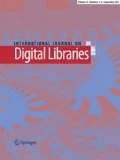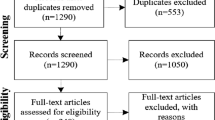Abstract
We present the results and the lessons learned from two separate and independent studies into the design, development, and evaluation of electronic books for information access: the Visual Book and the Hyper-TextBook. The Visual Book explored the importance of the visual component of the book metaphor in the production of “good” electronic books for referencing. The Hyper-TextBook concentrated on the importance of models and techniques for the automatic production of functional electronic versions of textbooks. Both studies started from similar considerations on what kinds of paper books are suitable for translation into electronic form but di.er on the prominence given to book appearance and functionalities. The results of these two research projects are critically presented in this paper, with the aim of helping designers and implementers to better integrate appearance and functional aspects of books into a more general methodology for the automatic production of electronic books for information access.
Similar content being viewed by others
References
Agosti M, Colotti R, Gradenigo G (1991) A two-level hypertext retrieval model for legal data. In: Proceedings of ACM SIGIR, Chicago, October 1991, pp 316–325
Agosti M, Crestani F (1993) A methodology for the automatic construction of a Hypertext for Information Retrieval. In: Proceedings of the ACM symposium on applied computing, Indianapolis, IN, February 1993, pp 745–753
Agosti M, Crestani F, Melucci M (1995) Automatic authoring and construction of hypertext for Information Retrieval. ACM Multimedia Syst 3(1):15–24
Agosti M, Crestani F, Melucci M (1998) Electronic publishing, storage, dissemination and retrieval of a scientific journal through the Web. In: Proceedings of the IEEE ADL'98 conference, Santa Barbara, CA, pp 137–146
Agosti M, Smeaton A (eds) (1996) Information Retrieval and Hypertext. Kluwer, Boston
Allan J (1997) Building hypertext using Information Retrieval. Inf Process Manage 33(2):145–159
Arms WY, Michalak TJ (1990) Carnegie Mellon University. In: Arms C (ed) Campus strategies for libraries and electronic information. Digital Press, Bedford, MA
Barker P (1991) Interactive electronic books. Interact Multimedia 2(1):11–28
Barker P (1996) Living books and dynamic electronic libraries. Electron Libr 14(6):491–501
Barker P, Richardson S, Benest ID (1994) Human-computer interface design for electronic books. In: Proceedings of Online Information 94, 16th international online information meeting, London, pp 213–229
Belew R (2000) Finding out about: a cognitive perspective on search engines technology and the WWW. Cambridge University Press, Cambridge, UK
Benest ID, Morgan G, Smithurst MD (1987) A humanised interface to an electronic library. In: Proceedings of INTERACT' 87, pp 905–910
Bonime A (1992) Sony's Data Discman: a look at these new portable information machines and what they mean for CDROMdevelopers. CD-ROMProfessional, September, pp 55–65
Botafogo RA, Rivlin E, Shneiderman B (1992) Structural analysis of hypertextx: identifying hierarchies and useful metrics. ACM Trans Inf Syst 10(2):142–180
Burrill VA, Ogden JA (1989) VORTEXT: The hard-backed screen. Electron Publish 2(3):143–156
Callan JP (1994) Passage-level evidence in document retrieval. In: Proceedings of ACM SIGIR, Dublin, Ireland, July 1994, pp 302–310
Carroll JM, Mack RL, Kellog WA (1988) Interface metaphors and user interface design. In: Helander M (ed) Handbook of human computer interaction. Elsevier, Amsterdam, pp 67–85
Catenazzi N, Gibb F (1995) The publishing process: the hyper-book approach. J Inf Sci 21(3):161–172
Crestani F, Melucci M (1998) A case study of automatic authoring: from a textbook to a hyper-textbook. Data Knowl Eng 27(1):1–30
Crestani F, Ntioudis S (2002) User centred evaluation of an automatically constructed hyper-textbook. J Educat Multimedia Hypermedia 11(1):3–19
Crivellari F, Melucci M (2001) Automatic hyper-textbook web generation. In: Proceedings of the ACM symposium on applied computing (SAC), Las Vegas, pp 253–256
Dove R (1996) Lady freedome among us. http://www.lib.virginia.edu/etext/fourmill/ DovLady.html [last visited December 2004]
Egan D, Remde JR, Gomez LM, Landauer TK, Eberhardt J, Lochbaum CC (1989) Formative design-evaluation of Super-Book. ACM Trans Inf Syst 7(1):30–57
Egan DE, Lesk ME, Ketchum RD, Lochbaum CC, Remde JR, Littman M, Landauer TK (1991) Hypertext for the electronic library? CORE sample results. In: Proceedings of ACM Hypertext' 91, San Antonio, TX, December 1991, pp 299–312
Egan DE, Remde JR, Landauer TK, Lochbaum CC, Gomez LM (1989) Acquiring information in books and superbooks. Mach Mediated Learn 3:259–277
Feldman T (1990) The emergence of the electronic book. British National Bibliography Research, Publishers Association [Fund report 46], London, UK
Frakes WR, Baeza-Yates R (eds) (1992) Information Retrieval: data structures and algorithms. Prentice Hall, Englewood Cliffs, NJ
Frisse ME (1988) Searching for information in a medical handbook. Commun ACM 31(7):880–886
Furuta R, Plaisant C, Shneiderman B (1989) A spectrum of automatic hypertext constructions. Hypermedia 1(2):179–195
Gentner D, Nielsen J (1996) The anti-Mac interface. Commun ACM 39(8):70–82
Hansen WJ, Haas C (1988) Reading and writing with computers: a framework for explaining di.erences in performance. Commun ACM 37(9):1080–1089
Hayter M (1996) Lectrice. http://www.research.digital.com/SRC/virtualpaper/ [last visited December 2004]
Hersh WR, Molnar A (1995) Towards new measures of Information Retrieval evaluation. In: Proceedings of ACM SIGIR, Seattle, July 1995, pp 164–170
Joyce M (1987) Afternoon, a story. Eastgate Systems, Cambridge, MA
Landoni M (1997) The Visual Book system: a study of the use of the visual rethoric in the design of electronic books. PhD Thesis, Department of Information Science, University of Strathclyde, Glasgow, Scotland, UK, May 1997
Landoni M, Catenazzi N, Gibb F (1993) Hyper-books and visual- books in an electronic library. Electron Libr 11(3):175–186
Landoni M, Wilson R, Gibb F (2000) From the visual book to the web book: the importance of good design. In: Proceedings of ECDL2000, 4th European conference on research and advanced technology for digital libraries, Lisbon, Portugal, September 2000, pp 305–314
Landoni M, Wilson R, Gibb F (2001) Looking for guidelines for the production of electronic textbooks. Online Inf Rev 25(3):181–195
Lehmann-Haupt C (1998) Creating “the last book” to hold all the others. New York Times, 8 April 1998
Manes S (1999) Gutenberg need not worry – yet. Forbes, 8 February 1999
Miller S (1984) Experimental design and statistics, 2nd edn. Routledge, London, UK
Morkes J, Nielsen J (1997) Concise, scannable, and objective: how to write for the web. http://www.useit.com/papers/webwriting/writing.html [last visited December 2004]
Morkes J, Nielsen J (1998) Applying writing guidelines to web pages concise, scannable, and objective: how to write for the Web. http://www.useit.com/papers/webwriting/rewriting.html [last visited December 2004]
Nielsen J (2003) PDF: Un.t for human consumption. http://www.useit.com/alertbox/20030714.html [last visited December 2004]
Rothkopf EZ (1971) Incidental memory for location of information in text. J Verbal Learn Verbal Behav 10(6): 608–613
Rowley DE, Rhoades DG (1992) The cognitive jogthrough: a fast-paced user interface evaluation procedure. Proceedings of the SIGCHI conference on human factors in computing systems, Monterey, CA, pp 389–395
Salton G, Allan J (1993) Selective text utilization and text traversal. In: Proceedings of ACM Hypertext'93
Salton G, Allan J, Buckley C, Singhal A (1996) Automatic analysis, theme generation, and summarization of machinereadable texts. In: Agosti M, Smeaton AF (eds) Information retrieval and hypertext. Kluwer, Dordrecht, pp 51–73
Schilit BN, Price MN, Golovchinsky G, Tanaka K, Marshall CC (1999) As we may read: the reading appliance revolution. IEEE Comput 32(1):65–73
Shin D, Nam S, Kim M (1997) Hypertext construction using statistical and semantic similarity. In: Proceedings of ACM Digital Libraries, Philadelphia, July 1997, pp 57–63
Southall R (1989) Interfaces between the designer and the document. In: Andre J, Furuta R, Quint V (eds) Structured documents. Cambridge University Press, Cambridge, UK, pp 119–131
Wilson R, Landoni M, Gibb F (2002) A user-centred approach to ebook design. Electron Libr 20(4):322–330
van Rijsbergen CJ (1979) Information Retrieval, 2nd edn. Butterworths, London, UK
Author information
Authors and Affiliations
Corresponding author
Rights and permissions
About this article
Cite this article
Crestani, F., Landoni, M. & Melucci, M. Appearance and functionality of electronic books. Int J Digit Libr 6, 192–209 (2006). https://doi.org/10.1007/s00799-004-0113-9
Published:
Issue Date:
DOI: https://doi.org/10.1007/s00799-004-0113-9




